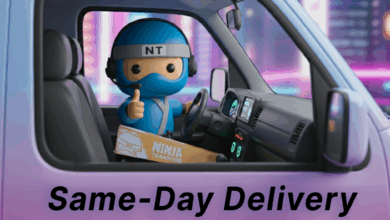If you run an embroidery shop, you probably have some heat transfer equipment too. Having a range of equipment allows you to broaden your services, which will ultimately attract more customers and generate more sales.
Here are a few ways to incorporate heat transfers into your embroidery designs and business.
- Use heat transfers to upsell your customers to bundles. “Boxes” are a huge trend right now in e-commerce, and custom apparel businesses can definitely benefit from the rise of this trend. If you’re unfamiliar with what boxes are, it’s just a modern way of offering unique bundles. Usually, these are set up as a monthly box with a recurring payment, but many e-commerce businesses are starting to sell boxes as a one-time sale with the option to renew again each month. If you sell online, consider offering boxes with embroidered and heat-transferred items. Heat-transferred items are typically cheaper and faster to make, so consider pairing one embroidered item with two heat transferred items to complete the bundle. You can create the boxes based on your specific audience’s interests. For instance, if you’re catering to the gym-goers market, think about decorators heat transferring a T or tank with a fun gym-related saying. The box can also include other items useful to gym-goers such as an embroidered cap, and a water bottle to complete the bundle.
- Use heat transfers as a discounted introductory offer. Many e-commerce clothing stores present an introductory offer that’s half-off or significantly reduced to get customers in the door. The idea is that you’ll attract more customers and that once they have bought from you, they’re more likely to buy again. While it’s easier to offer items at a high discount when you don’t have to spend the time creating them, it’s not as easy to offer highly discounted embroidered items because of the time and money that goes behind it. That’s why heat-transferred items, as they’re more cost-effective to create, make for great introductory offers in this industry. You can offer potential customers an $8-$10 heat-transferred shirt at $4-$5 to get them in the door. Chances are, they’ll need more than one, so the next time they come around, they’ll be likely to think of you, and you can sell your T at its regular price or upsell them to embroidery.
- Use heat transfer vinyl as appliqué material. Instead of using fabric for appliqué, you can embroider the outline of a design, place a sheet of heat transfer vinyl, and then lock it in with a satin stitch. This is a great technique for cutting production time on large orders, especially if you need to embroider a very large design such as a number or name on a jacket back. Once complete, place the shirt or jacket under a flat heat press for about 15 seconds to get the heat transfer vinyl to adhere to the garment.
- Layer heat transfers under embroidery. Layering adds a fun visual effect on your garment and works really well for T-shirts if you want a large design but don’t have the time to produce large embroidery designs for a bulk order. For instance, if you have an order for a team, consider a large heat transfer design of their logo in the center. Then, you can layer the name of the team across the edges of the design. Another perk of using heat transferring for a large design on a T? It won’t compromise the draping of the garment. It might come off blocky if you embroider a large design on thin fabric such as a T.
—Ricoma



